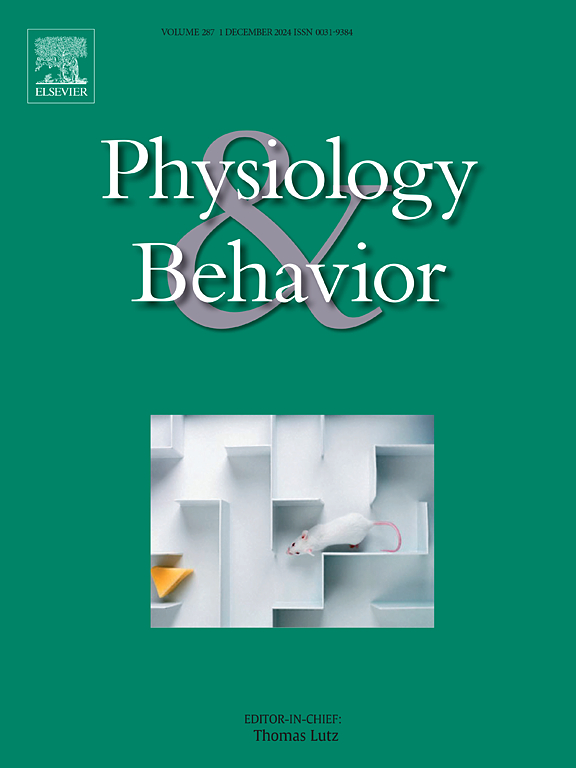自然奖励过程中的内源性大麻素和副大麻素系统:可能的药理学靶点?
IF 2.5
3区 医学
Q2 BEHAVIORAL SCIENCES
引用次数: 0
摘要
食物、交配和社会互动等自然奖励对生存和物种保护至关重要,它们的调节涉及动机、认知和情感过程的复杂相互作用。在过去的二十年里,人们越来越关注内源性大麻素系统及其副大麻素作为这些行为的关键调节剂。本文综述了内源性大麻素和副大麻素系统在调节自然奖励驱动行为中的作用,重点是喂养、生殖行为和社会互动。我们强调内源性大麻素系统-主要通过CB1受体信号传导-如何调节涉及能量稳态,奖励处理和情绪调节的中枢和外周电路。同时,我们探索了副大麻素的作用,如油基乙醇酰胺(OEA)、棕榈酰乙醇酰胺(PEA)和硬脂酰乙醇酰胺(SEA),它们主要通过非大麻素受体起作用,并有助于调节食欲、性动机和社会行为。特别关注这些系统在肥胖、饮食失调、性功能障碍和社交障碍的病理生理学中的相关性,以及它们作为药理学靶点的潜力。总的来说,所讨论的证据支持内源性大麻素和副大麻素信号作为自然奖励的关键调节因子的更广泛的概念,并为动机和奖励相关疾病的有针对性干预的发展开辟了新的途径。本文章由计算机程序翻译,如有差异,请以英文原文为准。
The endocannabinoid and paracannabinoid systems in natural reward processes: possible pharmacological targets?
Natural rewards such as food, mating, and social interaction are essential for survival and species preservation, and their regulation involves a complex interplay of motivational, cognitive, and emotional processes. Over the past two decades, increasing attention has been directed toward the endocannabinoid system and its paracannabinoid counterpart as key modulators of these behaviors. This review aims to provide an integrated overview of the roles played by the endocannabinoid and paracannabinoid systems in regulating natural reward-driven behaviors, focusing on feeding, reproductive behavior, and social interaction. We highlight how the endocannabinoid system - mainly through CB1 receptor signaling - modulates central and peripheral circuits involved in energy homeostasis, reward processing, and emotional regulation. In parallel, we explore the role of paracannabinoids, such as oleoylethanolamide (OEA), palmitoylethanolamide (PEA), and stearoylethanolamide (SEA), which act primarily via non-cannabinoid receptors and contribute to the regulation of appetite, sexual motivation, and social behavior. Special attention is given to the relevance of these systems in the pathophysiology of obesity, eating disorders, sexual dysfunctions, and social impairments, as well as their potential as pharmacological targets. Overall, the evidence discussed supports a broader conceptualization of endocannabinoid and paracannabinoid signaling as pivotal regulators of natural rewards and opens new avenues for the development of targeted interventions for motivational and reward-related disorders.
求助全文
通过发布文献求助,成功后即可免费获取论文全文。
去求助
来源期刊

Physiology & Behavior
医学-行为科学
CiteScore
5.70
自引率
3.40%
发文量
274
审稿时长
47 days
期刊介绍:
Physiology & Behavior is aimed at the causal physiological mechanisms of behavior and its modulation by environmental factors. The journal invites original reports in the broad area of behavioral and cognitive neuroscience, in which at least one variable is physiological and the primary emphasis and theoretical context are behavioral. The range of subjects includes behavioral neuroendocrinology, psychoneuroimmunology, learning and memory, ingestion, social behavior, and studies related to the mechanisms of psychopathology. Contemporary reviews and theoretical articles are welcomed and the Editors invite such proposals from interested authors.
 求助内容:
求助内容: 应助结果提醒方式:
应助结果提醒方式:


